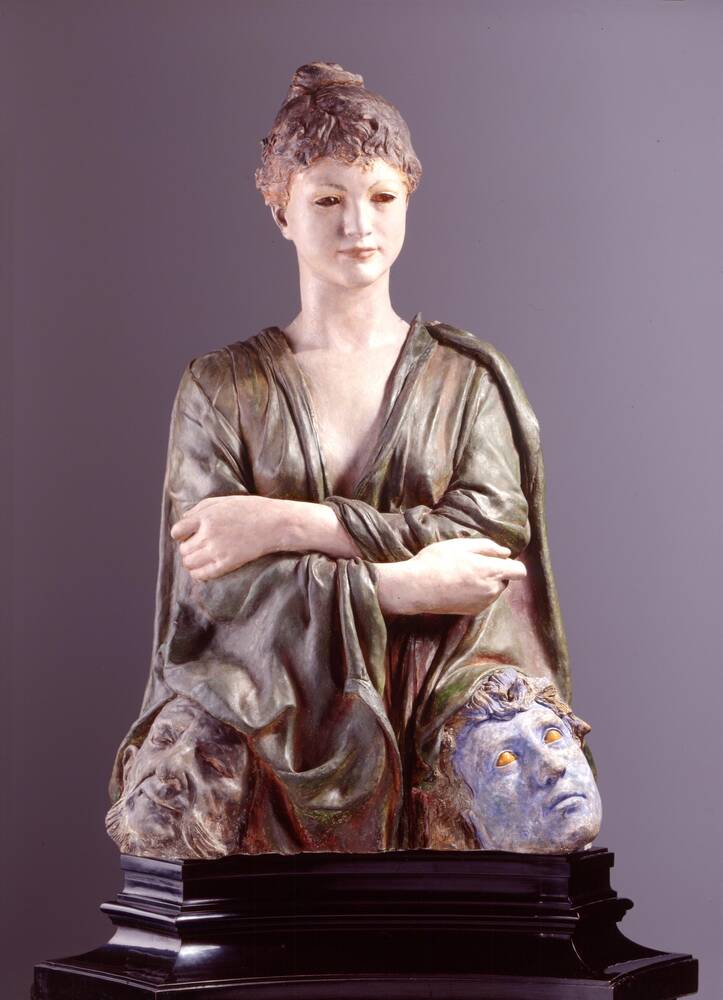In 1900, when Georg Treu, Director of the Dresden Sculpture Collection in the Albertinum, saw Max Klinger’s The New Salome, he is said to have commented:
“A modern little predatory creature.”
Here, you can see Klinger’s plaster model painted by his own hand. In Georg Treu’s words:
“How well her dangerous dark eyes, headstrong little nose, and cold narrow lips match the position of her arms, crossed with a smug naïve cruelty over the distorted heads of her dying victims.”
In the biblical story, Salome performs a seductive dance for King Herod. As a reward, she asks for the head of John the Baptist. But Klinger has reinterpreted the biblical Salome, transforming her into a self-confident, modern femme fatale, bringing disaster on the men around her. Around 1900, this was a popular trope of women resonating with a zeitgeist when many men felt threatened by women’s growing success in their fight for political and social rights. Might that also have been true for Georg Treu?
Klinger’s Salome sculpture is also painted – another example of his modern approach. In the late nineteenth century, the cry was often, ‘sculptures have to be white’ – best of all, in brilliant marble, echoing those statues known from classical world. But Klinger was up on the latest developments. He knew that ancient sculptures had also been found bearing traces of colour – and he reached for his paints. Klinger’s New Salome is considered a key work of painted sculpture in the late nineteenth century. But Max Klinger also dared to do something unheard of – mixing materials. Have you noticed Salome’s wonderful eyes are made of amber?
Further Media
Dresden around 1900
“At the end of the nineteenth century, Dresden was seen as rather a sleepy centre of the arts. For a long time, prevailing taste remained fixed on the styles of the first half of the 1800s, with the Nazarene and Romantic artists. The fresh generations only gradually managed to introduce new developments, in particular, in Dresden as well.”
The novel approaches mentioned by curator Andreas Dehmer came in many forms. The young artists in the late 1800s produced highly innovative styles of art – Impressionism, Symbolism, and Jugendstil, the German counterpart to Art Nouveau. These new art movements were controversial, but they also found adherents in conservative Dresden. One of the directors of the Dresden Collections recalled:
“There were flashes of lightning here and there and, to its great benefit, some of the big fish in this pond – including directors of the art collections – stirred up a surface previously unruffled by even the slightest breath of wind. And the names which emerged were ones never heard before: Böcklin, Uhde, Liebermann, Thoma, Klinger.”
But directors were not empowered to take unilateral decisions on acquisitions.
“One of the royal offspring always sat on the Acquisitions Commission and, when it came to art, the King himself certainly had his own ideas – not quite as forceful as Wilhelm II, the German Emperor, who described all Impressionism as the ‘art of the gutter’. The views in Saxony were not quite as intransigent. Admittedly, though, it proved very difficult to have new developments accepted, such as the art of Max Klinger or, above all, Arnold Böcklin. In some cases, such matters even reached the Saxony state parliament, where they triggered fierce and bitter debates on what is good and bad art.”
Restoring the sculpture
As was already mentioned, Klinger’s New Salome is a plaster model. Later, Max Klinger made a version in marble – today in the MdbK, the Museum of Fine Arts in Leipzig. But as restorer Stefanie Exner points out, Klinger also viewed this plaster model as an art work in itself:
“For the artist himself, this is a totally independent work which, as he said, has been decoratively painted in a ‘rather complex way’. So in this version, as we could say, Klinger experimented with different colours applied in a number of layers. For example, a layer of madder red is visible under the green of Salome’s gown. Similarly, along the hairline, blue elements shimmer through under the brown hair.”
Klinger appears to have made the colours himself, mixing the pigments with various bonding agents, such as oil, wax, and lime paste. But this resulted in various problems, even soon after Klinger finished painting the work. Some layers of colour did not bind well, which led to colour loss even in those early days. When restoration work started on the plaster figure in 1994, over 80 per cent of the facial painting had been lost as well as around 30 per cent of the colours on the gown. The restoration work aimed at supplementing the colour layers as faithfully as possible.
“But how can you do that without any precise information or photos? The hands, at least, were in a better condition, and they served as a basis for retouching the paint. The idea was to leave the remnants of shading around the eyes visible, as well as the eyebrows, and the red of the lips. So these parts were only minimally strengthened. As you now see, the result is a unified painted image – but, yes, to a certain extent, this is also deceptive.”
Today, we can no longer reconstruct how Klinger actually painted Salome’s face.
- Location & Dating
- 1887/88
- Material & Technique
- Plaster, painted
- Dimenions
- H: 86 cm, B: 53 cm, T: 40 cm
- Museum
- Skulpturensammlung
- Inventory number
- ZV 1269
